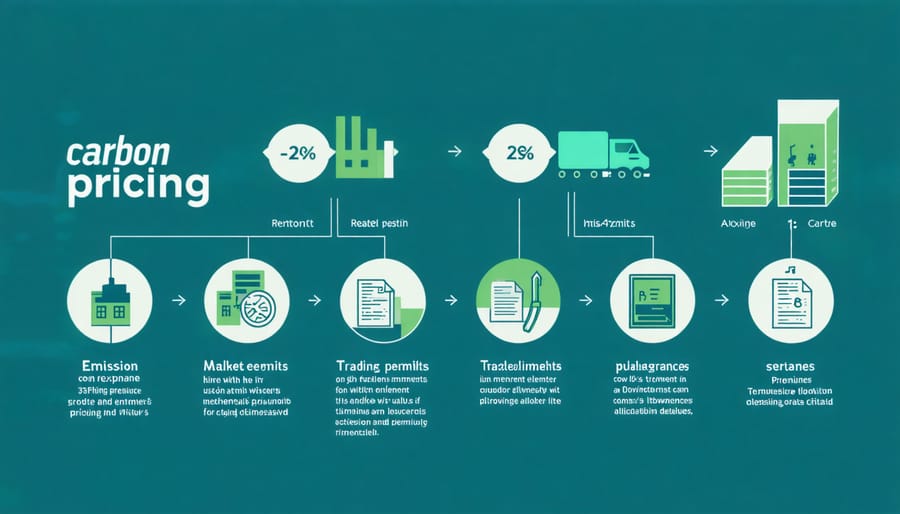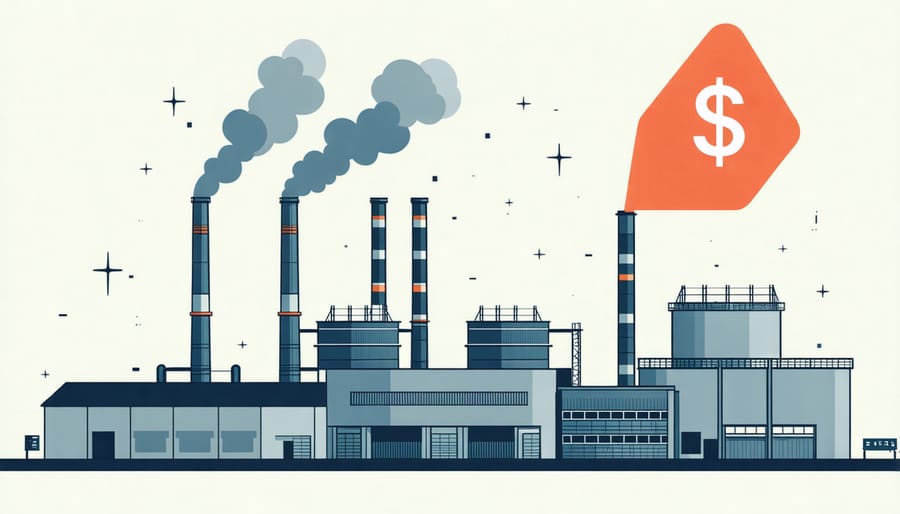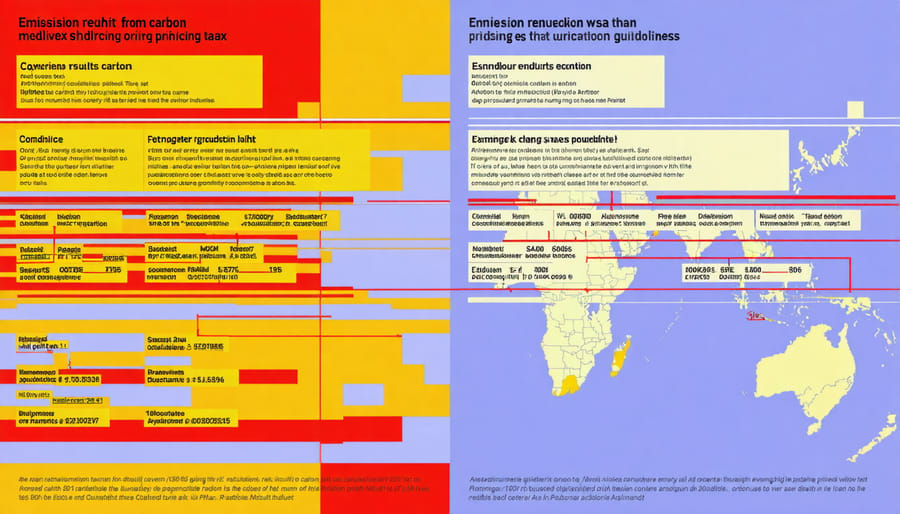As Australia grapples with its climate commitments, the debate between carbon pricing and carbon tax mechanisms has moved to the forefront of our national conversation. These market-based solutions represent two distinct approaches to reducing greenhouse gas emissions, each offering unique advantages for our sunburnt country. While both strategies aim to put a price on carbon emissions, their implementation methods and economic impacts differ significantly, creating important considerations for Australian businesses and households alike.
The urgency of climate action demands clear understanding of these tools, particularly as our nation transitions towards a cleaner energy future. Carbon pricing operates like a market-driven system where emission permits are traded, allowing businesses flexibility in how they reduce their carbon footprint. Meanwhile, the carbon tax approach provides a straightforward, fixed-price signal that gives businesses certainty in planning their emission reduction strategies.
For everyday Australians and business owners, understanding these mechanisms isn’t just about compliance – it’s about actively participating in our country’s journey towards sustainability while maintaining economic prosperity. Let’s explore how these approaches work in practice and what they mean for our shared future.
Understanding Carbon Pricing in Australia
How Carbon Pricing Works
Carbon pricing mechanisms operate on a simple yet effective principle: they put a price tag on greenhouse gas emissions, creating a financial incentive for businesses to reduce their carbon footprint. Think of it as a market-driven approach where companies that emit less carbon gain a competitive advantage.
In Australia’s context, carbon pricing works by setting a price per tonne of carbon dioxide emitted. Companies then have two choices: they can either reduce their emissions through cleaner technologies and improved processes, or they can purchase carbon credits to offset their emissions. This creates a marketplace where emissions become a manageable business cost.
The system encourages innovation and efficiency across industries. For instance, a manufacturing company in Melbourne might invest in solar panels to power their operations, reducing both their emissions and their carbon costs. Similarly, a Brisbane-based logistics firm might upgrade their fleet to electric vehicles, benefiting from lower carbon prices while contributing to cleaner air.
The flexibility of this approach allows businesses to find the most cost-effective ways to reduce their emissions, while the market determines the most efficient price for carbon.

Current Australian Carbon Credit Units (ACCUs)
Australian Carbon Credit Units (ACCUs) represent our nation’s primary carbon offset mechanism, where one ACCU equals one tonne of carbon dioxide equivalent emissions avoided or stored. This system enables Australian businesses and individuals to earn credits through projects that reduce greenhouse gas emissions, such as reforestation, improving energy efficiency, or capturing methane from landfills.
The ACCU market has shown promising growth, with increasing participation from both voluntary buyers and businesses meeting their compliance obligations. In recent years, the average price per unit has fluctuated between $16 and $30, reflecting the dynamic nature of the carbon market and growing demand for quality Australian carbon credits.
Local success stories include Indigenous-managed savanna burning projects in Northern Australia and sustainable farming practices across the Murray-Darling Basin. These initiatives not only generate carbon credits but also create additional benefits like improved biodiversity and sustainable employment opportunities for regional communities.
However, the effectiveness of ACCUs continues to evolve. The system has faced scrutiny over credit integrity and measurement methods, leading to ongoing improvements in verification processes. Despite these challenges, ACCUs remain a valuable tool in Australia’s emissions reduction strategy, providing flexibility for businesses while encouraging innovative climate solutions.
The Carbon Tax Alternative

Structure and Implementation
A carbon tax operates through a straightforward mechanism where businesses pay a fixed price for each tonne of carbon emissions they produce. Understanding how carbon tax works is crucial for Australian businesses and communities looking to reduce their environmental impact.
The implementation typically involves setting a price per tonne of CO2 emissions, which encourages businesses to reduce their carbon footprint through more efficient practices or renewable energy adoption. For example, a manufacturer might pay $25 for each tonne of carbon dioxide released during production, creating a direct financial incentive to lower emissions.
In Australia, the structure requires careful consideration of industry-specific factors and regional economic conditions. Key implementation elements include:
– Establishing emissions measurement and reporting systems
– Creating a transparent pricing mechanism
– Developing support programs for affected industries
– Setting up compliance monitoring
– Providing transition assistance for communities
The revenue generated from carbon taxes can be reinvested into renewable energy projects, support for affected communities, or returned to households through reduced energy bills. This approach ensures the system benefits both the environment and local communities while driving meaningful change in business practices.
Learning from Australia’s Past Carbon Tax Experience
Australia’s brief experience with a carbon tax from 2012 to 2014 offers valuable insights into the implementation and impact of carbon pricing mechanisms. During this period, large businesses were charged $23 per tonne of carbon emissions, which increased to $24.15 in the second year.
The policy showed promising results in its short lifespan, with emissions from electricity generation dropping by 8.2% in the first year, while renewable energy investment increased significantly. The carbon tax revenue was strategically redistributed through tax reforms and support for low-income households, helping to offset potential cost-of-living impacts.
However, despite these environmental gains, the policy faced significant political and public resistance, primarily due to concerns about economic impacts and rising electricity prices. This experience highlighted the importance of clear communication about policy benefits and the need for broader community support for climate action.
The lessons learned have shaped current discussions about carbon pricing in Australia, emphasising the need for a more collaborative approach between government, industry, and communities. Many experts suggest that future carbon pricing mechanisms should focus on gradual implementation and clearer messaging about the long-term benefits for both the environment and the economy.
Comparing Impact and Effectiveness
Economic Implications
Both carbon pricing mechanisms and carbon taxes have distinct economic implications for Australian businesses and households. Under a market-based approach, businesses typically face variable costs that reflect real-time supply and demand, allowing for more flexibility in managing their emissions. This can lead to more cost-effective solutions as companies find innovative ways to reduce their carbon footprint.
For consumers, the impact often manifests in slightly higher prices for energy-intensive products and services. However, many Australian businesses have found that these costs can be offset through improved efficiency and reduced energy consumption. Small businesses, in particular, have shown remarkable adaptability by implementing energy-saving measures and passing these savings on to customers.
The revenue generated from both systems can be reinvested into renewable energy projects or returned to communities through tax cuts and rebates, creating a positive economic cycle. Many Australian industries have already demonstrated that adapting to carbon pricing can drive innovation and create new job opportunities in sustainable sectors, particularly in regional areas.
Environmental Outcomes
Both carbon pricing and carbon tax mechanisms have shown promising results in reducing greenhouse gas emissions across Australia and globally. Studies indicate that carbon pricing systems typically achieve a 2-5% annual reduction in emissions from participating sectors, while carbon taxes have demonstrated reductions of 1-3% per year in countries where they’ve been implemented.
In Australia, the former carbon pricing mechanism (2012-2014) led to a notable 8% decrease in emissions from the electricity sector during its brief operation. This real-world example showcases how market-based approaches can drive significant environmental improvements. Similarly, successful carbon tax programs in British Columbia have reduced emissions by approximately 5-15% since implementation.
What’s particularly encouraging is how both systems promote innovation in clean technology. Australian businesses under these schemes have increasingly invested in renewable energy and energy-efficient practices. The key difference lies in their flexibility – carbon pricing allows for market-driven adjustments, while carbon taxes provide more predictable emission reduction pathways.
Local success stories include major Australian manufacturers reducing their carbon footprint by 25% after implementing internal carbon pricing, demonstrating that both approaches can deliver meaningful environmental outcomes when properly designed and implemented.
Implementation Challenges
While both carbon pricing mechanisms offer promising solutions for emissions reduction, their implementation faces several real-world challenges in the Australian context. Public acceptance remains a key hurdle, with many communities concerned about potential cost-of-living impacts. Business stakeholders often express worry about international competitiveness, particularly in energy-intensive industries that compete with countries without similar carbon costs.
Administrative complexity presents another significant challenge. Establishing accurate measurement systems for emissions and creating effective monitoring frameworks requires substantial infrastructure and expertise. For smaller businesses, this can mean additional compliance costs and administrative burden.
Political stability is crucial for the success of any carbon pricing system. Policy uncertainty can discourage long-term business investments in low-carbon technologies and infrastructure. The Australian experience has shown how changes in government can lead to significant shifts in climate policy direction.
Regional considerations also play a vital role, particularly in communities heavily dependent on carbon-intensive industries. The transition needs to be managed carefully to ensure fair outcomes across different regions and socioeconomic groups, with special attention to supporting affected workers and communities through the change.
Real-World Success Stories
International Carbon Pricing Examples
Several countries have successfully implemented carbon pricing schemes, offering valuable lessons for Australia. The European Union’s Emissions Trading System (EU ETS), launched in 2005, stands as the world’s largest carbon market, covering about 40% of the EU’s greenhouse gas emissions. Through this system, emissions from regulated sectors have decreased by approximately 35% since its inception.
New Zealand’s emissions trading scheme, particularly relevant to Australia due to similar economic and geographic conditions, has been operating since 2008. The Kiwi model demonstrates how agricultural emissions can be managed effectively while maintaining economic growth, with the scheme now covering all major sectors of their economy.
British Columbia in Canada provides an inspiring example of a successful carbon tax implementation. Since 2008, they’ve reduced emissions by 15% while maintaining strong economic growth. The revenue-neutral approach, where carbon tax proceeds are returned to citizens through tax cuts and rebates, has helped maintain public support for the program.
China’s national emissions trading scheme, though relatively new, is already the world’s largest by volume. Despite initial challenges, their phased approach to implementation offers insights into managing transition periods in large, diverse economies like Australia’s. Their experience shows how careful planning and sector-by-sector rollout can help smooth the implementation process.

Carbon Tax Success Stories
British Columbia’s carbon tax success stands as a shining example of effective climate action. Since implementing their carbon tax in 2008, the Canadian province has reduced emissions by 5-15% while maintaining strong economic growth. What’s particularly inspiring is how the revenue generated has been returned to citizens through tax cuts and rebates, making it a model of fair implementation.
Here in our region, New Zealand’s emissions trading scheme has demonstrated remarkable progress since its enhancement in 2020. The Kiwis have successfully reduced their industrial emissions while supporting their agricultural sector through targeted reinvestment of carbon tax revenues.
Sweden offers another encouraging case study, having maintained one of the world’s highest carbon tax rates since 1991. Despite initial concerns, Swedish businesses have thrived, with the country’s GDP growing by 60% while emissions dropped by 25%. Their success shows how early adoption of carbon pricing can drive innovation and create new business opportunities.
These success stories hold valuable lessons for Australia. Like British Columbia, we have resource-dependent regions that need support during the transition. Similar to New Zealand, we face unique challenges in agriculture. The Swedish experience shows us that ambitious climate action can coexist with economic prosperity. These examples demonstrate how well-designed carbon taxes can reduce emissions while fostering innovation and protecting vulnerable communities.
As we look towards Australia’s carbon-neutral future, both carbon pricing and carbon tax mechanisms offer viable pathways for reducing emissions. The evidence suggests that a well-designed carbon pricing system, particularly an emissions trading scheme, could provide greater flexibility and cost-effectiveness for Australian businesses while achieving meaningful emission reductions.
The success stories from countries like New Zealand and parts of Europe demonstrate that market-based approaches can drive innovation and encourage businesses to adopt cleaner technologies. For Australia, a hybrid system that combines elements of both mechanisms might offer the best solution, providing the certainty of a carbon tax with the flexibility of carbon pricing.
To maximise effectiveness, Australia’s emission reduction strategy should prioritise:
– Gradual implementation to allow businesses time to adapt
– Clear price signals that encourage long-term investment in clean technology
– Support mechanisms for emissions-intensive, trade-exposed industries
– Revenue recycling to assist vulnerable communities and fund clean energy initiatives
– Regular review and adjustment of targets based on scientific evidence
The path forward requires collaboration between government, industry, and communities. By learning from international experiences and adapting solutions to our unique context, Australia can develop a robust emission reduction framework that supports both environmental and economic goals.
The transition to a low-carbon economy presents challenges, but it also offers unprecedented opportunities for innovation, job creation, and sustainable growth. With proper planning and community engagement, Australia can emerge as a leader in climate action while maintaining its competitive advantage in the global marketplace.
